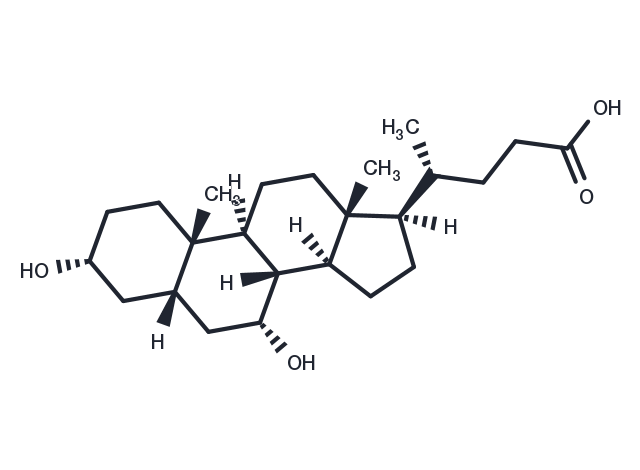Powder: -20°C for 3 years | In solvent: -80°C for 1 year
Chenodeoxycholic acid (CDCA) 是一种胆汁酸,通常与甘氨酸或牛磺酸结合。它作为清洁剂溶解脂肪以供肠道吸收,并被小肠重新吸收。它被用作利胆剂、利胆泻药,以及预防或溶解胆结石。

| 规格 | 价格/CNY | 货期 | 数量 | |
|---|---|---|---|---|
| 20 mg | ¥ 190 | 现货 | ||
| 1 mL * 10 mM (in DMSO) | ¥ 190 | 现货 | ||
| 产品描述 | Chenodeoxycholic acid (CDCA) is a bile acid, usually conjugated with either glycine or taurine. It acts as a detergent to solubilize fats for intestinal absorption and is reabsorbed by the small intestine. It is used as cholagogue, a choleretic laxative, and to prevent or dissolve gallstones. |
| 体外活性 | Chenodeoxycholic acid (CDCA)和脱氧胆酸(DCA)均可抑制11 beta HSD2,其IC(50)值分别为22 mM和38 mM。Chenodeoxycholic acid 诱导皮质醇依赖性核内转位,增加矿物皮质激素受体(MR)的转录活性。[1] Chenodeoxycholic acid 通过激活膜G蛋白偶联受体(TGR5)依赖性通路,显著促进Ishikawa细胞生长,增加Cyclin D1蛋白和mRNA表达。[2] 在培养的人类肝母细胞瘤细胞系Hep G2中,Chenodeoxycholic acid 可使LDL受体mRNA水平提高近4倍,HMG-CoA还原酶和HMG-CoA合酶mRNA水平提高2倍。[3] Chenodeoxycholic acid 诱导的Isc被Bumetanide、BaCl2和囊性纤维化跨膜导电调节器(CFTR)抑制剂CFTRinh-172抑制(≥67%)。Chenodeoxycholic acid 激活的Isc被腺苷酸环化酶抑制剂MDL12330A降低43%,Chenodeoxycholic acid 增加细胞内cAMP浓度。[4] Chenodeoxycholic acid 通过增加其磷酸化、核内积聚来激活C/EBPβ。Chenodeoxycholic acid 增强了含有C/EBP响应元素(pGL-1651)的-1.65-kb GSTA2启动子结构的荧光素酶基因转录。Chenodeoxycholic acid 激活AMP激活的蛋白激酶(AMPK),促进细胞外信号调节激酶1/2(ERK1/2)的激活。[5] |
| 激酶实验 | Briefly, transfected HEK-293 cells, incubated in charcoal-treated Dulbecco's modified Eagle's medium for 24 h, are washed once with Hanks' solution and resuspended in a buffer containing 100 mM NaCl, 1 mM MgCl2, 1 mM EDTA, 1 mM EGTA, 250 mMsucrose, 20 mM Tris-HCl, pH 7.4. Cells are lysed by freezing in liquid nitrogen. Dehydrogenase activity is measured in a final volume of 20 μL containing the appropriate concentration of bile acid, 30 nCi of [3H]cortisol, and unlabeled cortisol to a final concentrations of 50 nM. The reaction is started by mixing cell lysate with the reaction mixture. Alternatively, endoplasmic reticulum microsomes are prepared from transfected HEK-293 cells and incubated with reaction mixture containing various concentrations of cortisol and CDCA. Incubation proceeded for 20 min, and the conversion of cortisol to cortisone is determined by thin layer chromatography (TLC). Because of the inaccuracy of the TLC method at low conversion rates and the end-product inhibition of 11βHSD2 at conversion rates higher than 60-70%, only conversion rates between 10 and 60% are considered for calculation. The inhibitory constant IC50 is evaluated using the curve-fitting program. Results are expressed as means±S.E. and consist of at least four independent measurements. |
| 细胞实验 | The cell viability is analyzed by incubating transfected HEK-293 cells and CHO cells for 1 h with the corresponding concentration of bile acid and staining with trypan blue. The toxicity of bile acids is analyzed using the tetrazolium salt MTT (3-(4,5-dimethylthiazol-2-yl)-2,5-diphenyltetrazolium bromide) according to the cell proliferation kit I. No significant differences between control and bile acid-treated cells are obtained in both tests. |
| 别名 | CDCA, 鹅去氧胆酸, Chenodiol |
| 分子量 | 392.57 |
| 分子式 | C24H40O4 |
| CAS No. | 474-25-9 |
Powder: -20°C for 3 years | In solvent: -80°C for 1 year
Ethanol: 79 mg/mL (201.23 mM)
DMSO: 79 mg/mL (201.23 mM)
H2O: < 1 mg/mL (insoluble or slightly soluble)
| 可选溶剂 | 浓度 体积 质量 | 1 mg | 5 mg | 10 mg | 25 mg |
| Ethanol / DMSO | 1 mM | 2.5473 mL | 12.7366 mL | 25.4732 mL | 63.6829 mL |
| 5 mM | 0.5095 mL | 2.5473 mL | 5.0946 mL | 12.7366 mL | |
| 10 mM | 0.2547 mL | 1.2737 mL | 2.5473 mL | 6.3683 mL | |
| 20 mM | 0.1274 mL | 0.6368 mL | 1.2737 mL | 3.1841 mL | |
| 50 mM | 0.0509 mL | 0.2547 mL | 0.5095 mL | 1.2737 mL | |
| 100 mM | 0.0255 mL | 0.1274 mL | 0.2547 mL | 0.6368 mL |
| 中药材名称 | 中药材拉丁名 | 性 | 味 | 归经 |
| 白屈菜 | Chelidonium majus L. | 凉 | 苦 | 肺, 胃 |
| 荷包牡丹根 | Dicentra spectabile(L.)Lem. | 温 | 辛 | 肝 |
| 荷青花 | Hylomecon Japonicum | 平 | 苦 |
| 中成药名称 | 处方组成 | 主治疾病 | 中成药类型 |
| 胃刻宁片 | 白屈菜,黄柏,海螵蛸,白矾(煅),薄荷脑 | 口服,一次4~6片,一日3次。 | 理气药 |
| 胃痛平糖浆 | 白屈菜 | 口服,1个月至6个月小儿一次3ml,7个月至一岁一次5ml,一至三岁一次8ml,四至五岁10ml,六岁以上酌情增加;一日2次。 | 温里药 |
| 元秦止痛注射液 | 延胡索,制川乌,秦艽,粉防己,白屈菜 | 痛时用,肌肉注射,一次1支,一日三次。可连续使用6次,使用时间间隔不少于7小时。 | 祛瘀药 |
| 新型狗皮膏 | 川乌,羌活,高良姜,肉桂,当归,防己,麻黄,红花,洋金花,白屈菜,花椒,蟾酥,白花菜子,透骨草,没药,乳香,薄荷脑,冰片,樟脑,水杨酸甲酯,八角茴香油,盐酸苯海拉明 | 贴患处。 | 和血药 |
| 胃刻宁胶囊 | 白屈菜,黄柏,海螵蛸,白矾(煅),薄荷脑 | 口服。一次4粒,一日3次。 | 理气药 |
| 小儿消咳片 | 白屈菜,百部,天冬,南沙参,白前,侧柏叶,木蝴蝶 | 口服,六个月至一岁小儿一次0.5片;一至四岁一次1片;三岁以上一次2片;一日3次。 | 清热药 |
| 小儿白贝止咳糖浆 | 白屈菜,瓜蒌,法半夏,平贝母 | 口服,六个月以内,一次1~5ml;七至十二个月,一次5~15ml;一至三岁,一次20ml;三至六岁,一次20~25ml;六至九岁,一次25~3Oml;九岁以上,一次30~50ml;一日3次。 | 化痰药 |
| 痛安注射液 | 青风藤,白屈菜,汉桃叶 | 肌内注射,一次2ml,一日2-3次。或遵医嘱。 | 祛湿药 |
| 复方白头翁胶囊 | 盐酸小檗碱,白屈菜,白头翁,秦皮 | 口服,一次4粒,一日3~4次。 | 清热药 |
| 天蟾胶囊 | 夏天无,制川乌,蟾酥,祖司麻,白屈菜,秦艽,白芷,川芎,白芍,甘草 | 口服。一次3粒,一日3次,5天为一疗程。 | 祛瘀药 |
| 小儿清热灵 | 白屈菜,寒水石,黄芩,重楼,柴胡,天竺黄,紫荆皮,射干,板蓝根,牛黄,菊花,冰片,蝉蜕,珍珠,黄连,麝香 | 口服,6个月以下小儿一次 1/2片;7~10个月一次 1片;1~2 岁一次 1片;2~ 3岁以上 3~ 5片;一日2次。 | 清热药 |
| 复方白头翁片 | 白头翁,盐酸小檗碱,白屈菜,秦皮 | 口服,一次4片,一日3~4次。 | 清热药 |
| 胃痛平胶囊 | 白屈菜 | 口服,一次4粒,一日3次。 | 清热药 |
对于不同动物的给药剂量换算,您也可以参考 更多...
请在以下方框中输入您的动物实验信息后点击计算,可以得到母液配置方法和体内配方的制备方法: 比如您的给药剂量是10 mg/kg,每只动物体重20 g,给药体积100 μL,一共给药动物10 只,您使用的配方为5% DMSO+30% PEG300+5% Tween 80+60% ddH2O。那么您的工作液浓度为2 mg/mL。
母液配置方法:2 mg 药物溶于 50 μL DMSO (母液浓度为 40 mg/mL), 如您需要配置的浓度超过该产品的溶解度,请先与我们联系。
体内配方的制备方法:取 50 μL DMSO 主液,加入 300 μL PEG300, 混匀澄清,再加 50 μL Tween 80,混匀澄清,再加 600 μL ddH2O, 混匀澄清。
您可能有的问题的答案可以在抑制剂处理说明中找到,包括如何准备库存溶液,如何存储产品,以及基于细胞的分析和动物实验需要特别注意的问题。
Chenodeoxycholic acid 474-25-9 Autophagy Membrane transporter/Ion channel Metabolism Potassium Channel FXR Endogenous Metabolite CDCA NR1H4 鹅去氧胆酸 Inhibitor inhibit Chenodiol inhibitor
